Chalk.com lists their mission as this:
“Giving every child an equal opportunity to participate in the future”
And that is more or less what Chalk.com does. It is a company that saw a disparity between the opportunities given to students in our education system, and their actual abilities. They saw how a child that was given more opportunities in education tended to perform better, and have better opportunities, the later they got in life. More doors opened for them, if you will. As their website says, “the [education] system needs to accommodate your needs to give you the best chance to succeed.” And their goal is to shape the system to do that.
Chalk.com strives to do this by starting at the source: the teachers themselves. They argue that good teaching is not something that is “mass-produced” but cultivated through people who care. Chalk wants to empower teachers in order so that they can better empower their students.
They attempt to do this by teaching teachers about what it means to learn well, to learn and act on knowledge with responsibility, to care about what they teach and who they teach, and to be persistent in all things. Though all of this might sound a little heady and nebulous, they live out these missions by scheduling meetings with teachers, helping them plan out curricula and game plans, developing holistic strategies to meet students and educators wherever they are.
 Nine years ago, Jeffrey Raider, Andrew Hunt, Neil Blumenthal, and David Gilboa founded a company called Warby Parker, a company which they hoped would address the need for eyeglasses in a different way.
Nine years ago, Jeffrey Raider, Andrew Hunt, Neil Blumenthal, and David Gilboa founded a company called Warby Parker, a company which they hoped would address the need for eyeglasses in a different way.